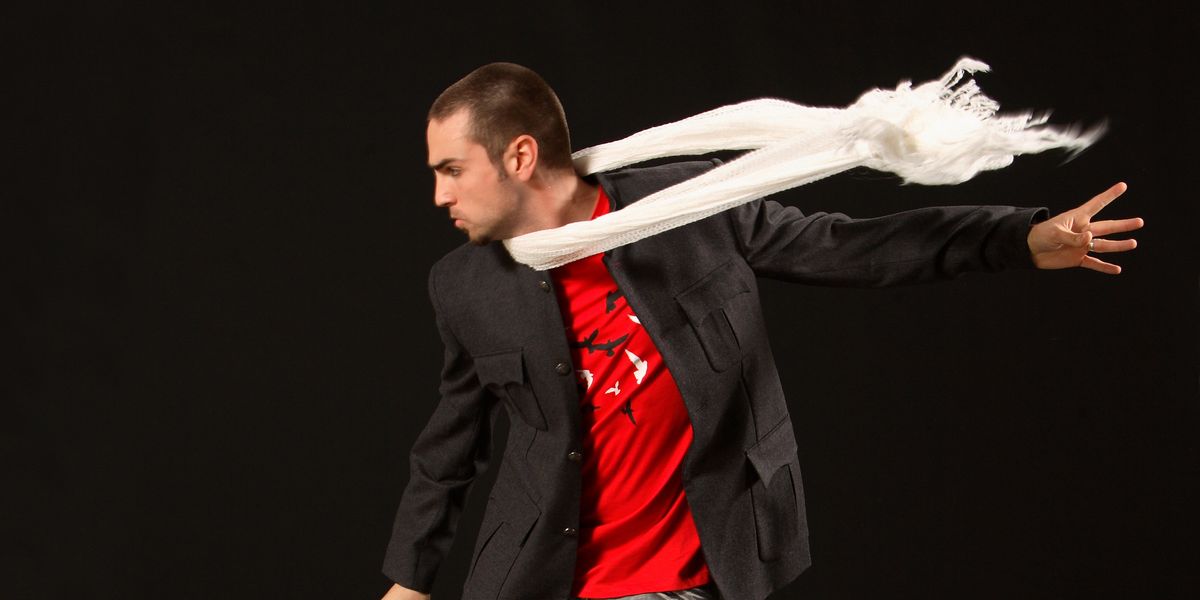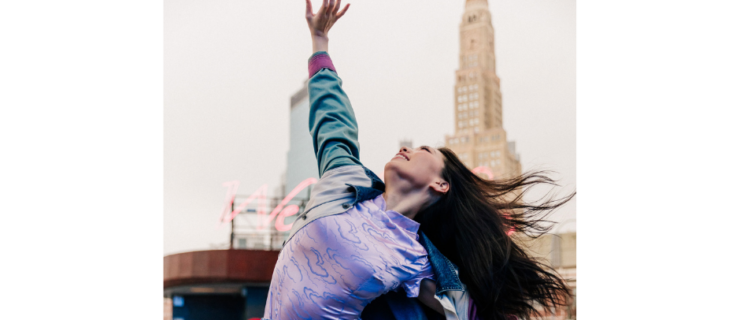Wade Robson: An Innovator at Work
Suited up in his high-water pants, white socks, black loafers and fedora, Wade Robson prepared for his first professional gig performing at the Michael Jackson concert in his hometown of Brisbane, Australia. He’d won a dance contest impersonating Jackson earlier that year, and the prize was to meet the King of Pop himself. Impressed with Robson’s fluid glides, sharp pops, and agile hips, Jackson asked him to dance in his concert the following night. Stepping into the spotlight during the finale, Robson moved downstage and threw his hat into an audience of thousands of adoring fans. He was just 5 years old.
“The first dancing I ever saw was in the “Thriller” video,” says Robson. “I think I was 2 years old and I started trying to do some of the movements. By the time I was 4, I learned the whole thing.” After the Jackson concert, Robson joined a local dance company and became something of a specialty act impersonating his idol. Even then, he demonstrated a knack for creating his own movement style. “I didn’t want to be choreographed,” he says. “I was just freestyling and doing my own thing.”
Robson moved to the U.S. with his mother and sister when he was 8 to pursue dance professionally. With the help of his old friend Jackson, who’d cast Robson in his “Black or White” and “Jam” music videos, he landed an agent and quickly made waves in the Los Angeles dance scene. He also began serious training with some of the West Coast’s legendary funk originators. Under the tutelage of Popin’ Taco and Popin’ Pete, Robson continued perfecting the street styles he so identified with in the “Thriller” video. “Wade was an eager beaver,” says Popin’ Pete. “He didn’t lose focus like some children do.”
But as Robson became more immersed in the profession, he learned he didn’t want to make a career as a performer. “I didn’t like the way dancers were treated like cattle. And I didn’t like the way they were paid,” he says. “I remember saying to my mom that I wanted to be a choreographer because I wanted to be in a position to fight for dancers to be respected.”
Beyond his desire to change industry standards, Robson also displayed a penchant for leadership. When he was just 12, he started teaching at Moro Landis, now Millennium Dance Complex, even though many dancers scoffed at the idea of a kid running a class. “People would walk out before I even started,” he says. “They’d ask, ‘Who’s teaching class?’ and people would say, ‘That little white boy over there with the shaved head.’ People would be like, ‘Yeah right, I’m not taking from this kid.’ ”
Yet Robson’s current pupils attest to his ability to break down intricate movement and his unique approach to setting choreography. “He didn’t just teach the steps,” says So You Think You Can Dance finalist Hok. “He started off with a feeling and a vision, and he played the music for us a couple times. Inside the room it was kind of dim and there were candles lit so we could get inside that mood. It felt like something beyond dancing. It was like a whole experience of art.”
Robson’s teaching turned heads, and he was offered his first choreography job at 14 for a boy band called Immature. In an era where saccharin pop was taking over the charts, Robson’s edgy movement style attracted artists looking to add some spice to their sticky-sweet repertoire. No one personified the bad-girl/good-girl dichotomy better than Britney Spears, who hired Robson to help create her signature sassy strut when he was a whopping 16 years old. Robson became a Spears mainstay over the next few years, choreographing her Pepsi commercials, 1999 MTV Movie Awards performance, world tours and I’m a Slave 4 U music video. He also began working with *NSYNC, directing their tours, as well as collaborating on songwriting for their final album, Celebrity. Other pop artists hired him, including Mya, Pink, Usher, and Mandy Moore. Robson’s choreography career was on fire before he’d even reached his 20s.
As Robson gained momentum, he reached new levels of recognition by hosting one of the first dance reality shows on television in 2003, aptly named The Wade Robson Project. The show’s premise was to search out raw talent (no trained dancers were allowed to audition) and eventually award the winner a $100,000 cash prize. And while Robson did sometimes perform on the show, he began to get noticed more for his TV persona than for his choreography. “I started gaining a certain amount of fame for being the cool guy on MTV,” he says, “and I did start to get caught up in that for a second.”
For all his success, though, Robson felt a tug in the opposite direction from the limelight. As the show was coming to a close, he was beginning a relationship with Amanda Rodriguez, now his wife, who grew up far away from the entertainment industry in Maui, Hawaii. “I was going through so many changes in my life with her—learning and remembering a whole aspect of myself that I’d forgotten,” he says. “She had this whole other perspective that I saw and loved and wanted to be a part of. But at the same time, I was becoming a bit of a celebrity. It was a really strange contrast.”
Robson’s choice became clear as he shot the finale for the show. “I looked around and had one of these strange, surreal moments where I said, ‘Is this it? Is this really what I want?’ I saw people looking at me for all the wrong reasons,” he says. For the next two years, he disappeared from the public eye and immersed himself in his new love, experiencing life without dance.
Robson’s relationship with Amanda has had a profound effect on his artistic vision. Now, before he even starts to think about choreography, he and Amanda sit down to create a story or theme for each piece. She is his muse, the influence behind his evolving approach. “I feel like I have so much to say as a person, behind the work, with both of our perspectives joined together,” says Robson. His creative process has become more organic, resulting in a change in movement vocabulary that reaches beyond his earlier street style. “When I was in my earlier pop phase, I was extremely calculated,” he says. “I’d have a nervous breakdown if I came into rehearsal and didn’t have everything worked out. Now, I’ll work out a foundation—if I need to move this dancer from stage left to stage right, how would this character walk? Then I let the creation happen once I get in there. That’s been really freeing. I think it’s helped my stuff a lot.”
It wasn’t long before he had a very public platform in which to test his inspired new approach. In 2005, he was beckoned back to the small screen with the introduction of the groundbreaking reality series So You Think You Can Dance. Robson was instrumental in introducing mainstream audiences to hybrid forms of dance, combining pedestrian movement with classically influenced technique.
“Wade is like a chameleon,” says So You Think You Can Dance contestant Jaimie Goodwin. “You really don’t think about him having a specific style. You never know what you’re going to get from him.” Last year, Robson pushed the envelope even further on the show, working well outside his comfort zone to create ’60s-inspired protest solos to John Mayer’s “Waiting on the World to Change,” (the next day Nigel Lythgoe “apologized” in case this peace dance offended any families of soldiers) and the hauntingly mesmerizing “Hummingbird” piece. Robson received high acclaim from the show’s judges on “Hummingbird” for his uncanny ability to transform a hip hop dancer (Hok) and well-rounded dancer (Goodwin) into stunning personifications of a hummingbird and flower.
“A lot of people have beautiful ideas, but they don’t know how to incorporate them and show them off,” says Goodwin. “But Wade can turn himself into different characters. He moves in a way that’s really not human. He sees his vision and knows how to get it across.”
Although Robson’s choreography is said to have no identifiable style, his early “Thriller” influence noticeably permeates much of his current work. His Emmy Award–winning “Ramalama (Bang Bang)” piece (part of So You Think You Can Dance‘s 2006 season) featured tweaked out zombies dressed in Victorian garb, while his Dancing With the Stars number in 2007 conjured up a dark, circusy funhouse ambiance.
Cirque du Soleil producers took notice and hired Robson to choreograph their next installment on the Vegas strip—a show centered on magician Criss Angel, set to open this summer at the Luxor hotel. Cirque looks to move in a new direction, making dance more central to the performance, and almost completely sidelining the acrobatics. They turned to Robson to create story-driven dance content, and declined to define a particular style for the show. “We’ll go with Wade a little bit everywhere,” says director Serge Denoncourt. “That’s why he’s here, because I don’t want a specific style of dance. I want to go anywhere with him to follow the storyline.”
Robson himself continues to go anywhere in the dance world that his heart desires. He’s been commissioned to create a piece for the San Francisco Ballet’s 75th Anniversary gala, even though he’s never studied ballet. “I’m just so excited to be in situations where I’m being put out of my comfort zone,” says Robson. “If you’re not challenging yourself, what’s the point?”
Robson challenges not only himself, but also the general public. “Hopefully in the future,” he says, “as I continue to push my own limits creatively, I’ll push the limits and boundaries of popular dance.”




